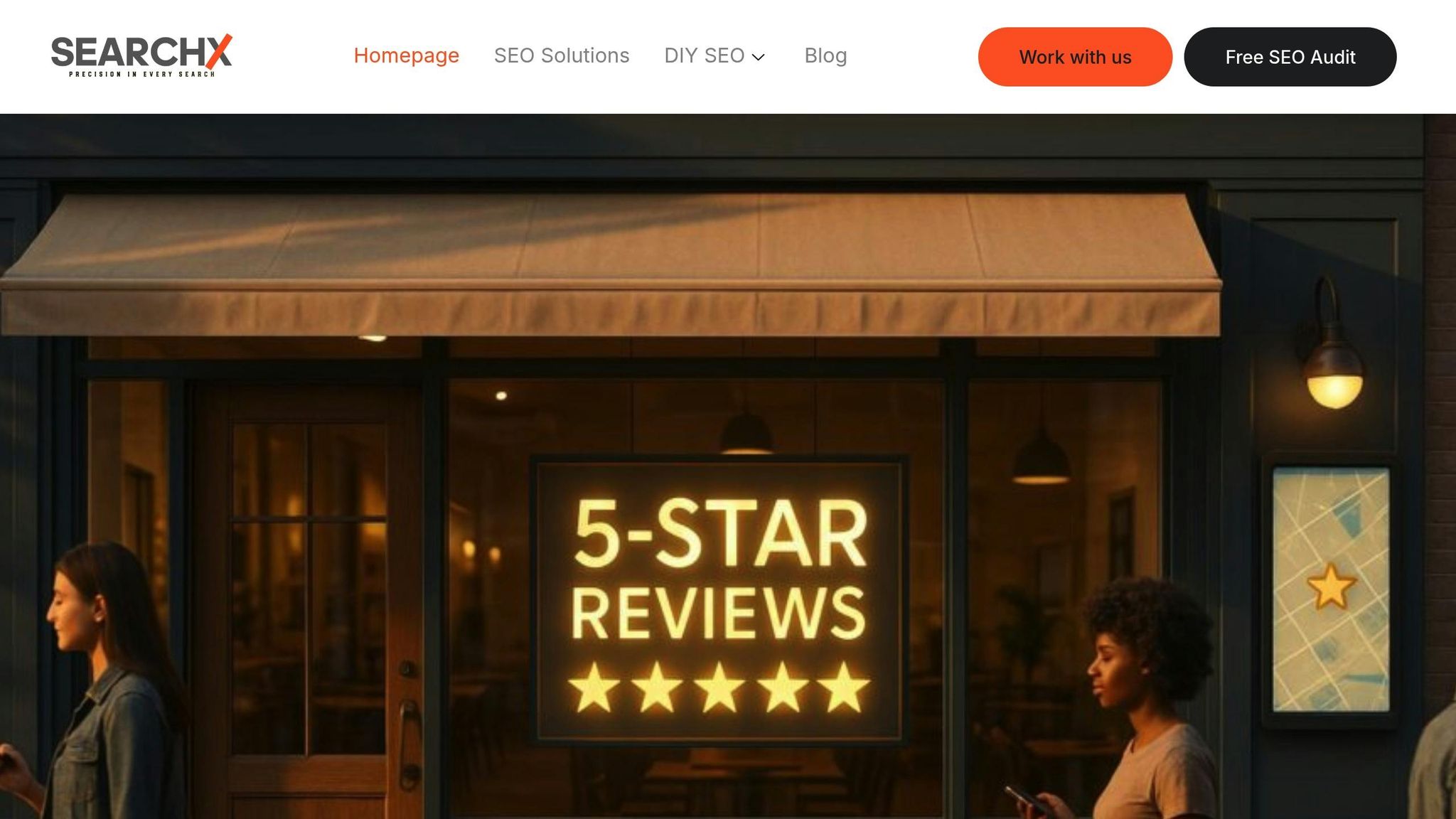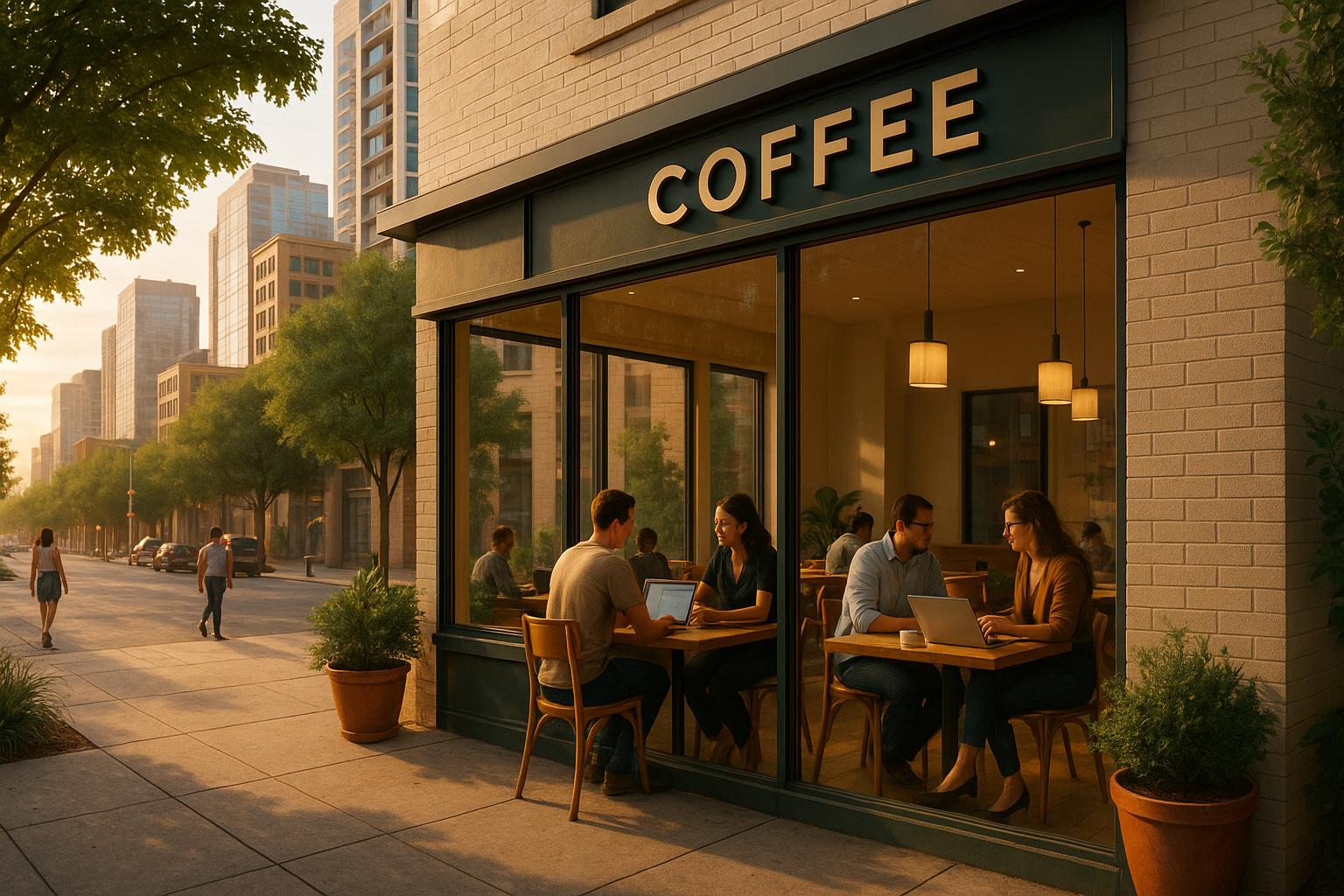Want to grow your Austin blog’s organic traffic? Focus on local SEO. Austin’s fast-growing population and vibrant culture make it a unique market, but standing out online requires more than generic strategies. Here’s a quick summary of what works:
- Use Austin-Specific Keywords: Include terms like "Austin TX", "ATX", or neighborhood names (e.g., "Zilker Park restaurants") to target local searches.
- Leverage Local Events: Create content around big events like SXSW or Austin City Limits to ride search trends.
- Optimize for Mobile: With over 60% of traffic coming from mobile devices, ensure your site loads fast and works well on phones.
- Add Schema Markup: Use local business and review schema to enhance your search visibility.
- Collaborate Locally: Partner with Austin businesses for backlinks and community engagement.
- Track Metrics: Monitor keyword rankings, click-through rates, and local search visibility to refine your strategy.
Local SEO Content Strategy: How To Create Evergreen Supporting Blog Content
Austin’s SEO Landscape: What You Need to Know
Austin’s digital search environment is unlike any other. The city’s unique blend of established companies, dynamic startups, and creative professionals shapes search behaviors in ways that can directly impact how your blog performs. By tapping into these patterns, you can position your content to attract the right kind of traffic. Let’s take a closer look at why local SEO is so important for connecting with Austin’s audience.
Why Local SEO Matters in Austin
Austin’s diverse economy creates a variety of search habits. For example, tech professionals near the Domain, creatives in East Austin, and foodies exploring South Lamar often pair general search terms with Austin-specific keywords. This combination creates an opportunity for blogs that focus on local relevance to stand out.
The city’s rapid population growth adds another layer of complexity. With a steady stream of new residents, there’s high demand for neighborhood guides and recommendations for local services. As a major metropolitan area, Austin also benefits from Google’s emphasis on local search signals. Content that reflects the city’s unique character and demonstrates community involvement can significantly boost visibility – not just for local searches but for broader topics as well.
In Austin’s competitive digital space, generic SEO strategies often miss the mark. Businesses and content creators who embrace Austin-specific tactics tend to outperform those relying on broader, nationwide methods.
Market Trends Affecting Austin SEO
Austin’s search trends often mirror its cultural calendar and economic shifts. Big events like South by Southwest (SXSW) and the Austin City Limits Music Festival drive noticeable spikes in event-related searches. These peak times are perfect for crafting targeted, timely content.
The tech industry’s influence is a year-round factor. Many Austin residents frequently search for topics like remote work, startup culture, and the latest tech trends. This tech-savvy audience also expects fast-loading websites and mobile-friendly experiences, making technical SEO a must for maintaining engagement.
Food culture is another major driver of local search traffic. Blogs highlighting new restaurants, food trucks, or dining recommendations – especially when tied to specific Austin neighborhoods – can gain significant traction.
Real estate remains a hot topic as the city continues to grow. Searches for neighborhood comparisons, cost-of-living insights, and local amenities are common, offering opportunities for location-focused content that addresses these needs.
Seasonal changes also play a role in shaping search behavior. Austin’s scorching summers lead to more searches for indoor activities, while the milder winters spark interest in outdoor events and activities. Timing your content to reflect these shifts can help maximize its impact.
Additionally, there’s a rising interest in sustainable living and eco-friendly initiatives within the community. Blogs that explore green practices or highlight local environmental efforts are likely to resonate with Austin audiences looking to make a positive impact.
Austin-Specific Keyword Research Methods
When it comes to Austin’s unique market, precision is key. Crafting an effective local SEO strategy starts with identifying the exact terms Austin residents and visitors use when searching for content tied to the area.
Target Geo-Specific Keywords
Austin locals and visitors often include location-specific terms like "Austin", "ATX", or "near me" in their searches. These long-tail, location-focused keywords typically face less competition and bring in more qualified leads compared to broader terms.
Start by brainstorming how people might refer to Austin in their searches. Variations like "Austin TX", "Austin Texas", "ATX", or even "Capital City" can target different audience segments. For example, instead of using a generic term like "BBQ restaurants", opt for something like "best BBQ joints in Austin" or "Austin food truck festivals." This approach allows you to compete in a more focused space where your local expertise can shine.
"Understanding local search patterns and analyzing regional language differences helps you identify the exact phrases your audience uses".
To take it a step further, incorporate references to specific neighborhoods and landmarks into your strategy.
Include Austin Neighborhoods and Landmarks
Austin’s neighborhoods each have their own flavor, attracting diverse audiences and search behaviors. People often look for content tied to specific areas, whether it’s a trendy neighborhood, a popular gallery district, or a bustling shopping hub. Including these local references in your keyword strategy can make your content more relevant.
Geo-modifiers like neighborhood names are powerful tools. For Austin, this means focusing on areas like Zilker, Clarksville, Mueller, Bouldin Creek, and Rainey Street. Each neighborhood appeals to different demographics, so tailoring your content to these areas can help you connect with niche audiences.
Landmarks are another goldmine for keywords. Phrases like "near Zilker Park", "downtown Austin", "UT campus area", or "Lake Austin" resonate with locals and visitors alike. Seasonal events like the Trail of Lights also offer opportunities to capture traffic during specific times of the year. Plan your content around these events and optimize for related search terms well ahead of time.
Avoid creating "doorway-page patterns" where the only change between pages is the city or neighborhood name. Instead, enrich your content with unique details – like local case studies or neighborhood-specific FAQs – to provide real value to your audience.
Study Competitor Keyword Strategies
Once you’ve built a refined keyword list, analyzing competitors can uncover additional opportunities. Studying what works for other Austin blogs and businesses can help you find "content gaps" – keywords your competitors rank for but you don’t. These gaps often highlight untapped opportunities.
Tools like SearchX can help you see which keywords competitors rank for in Austin-specific searches. Pay attention to patterns in their content. Do they focus on certain neighborhoods or highlight specific events? This can help you identify high-volume, low-competition keywords.
Competitor analysis also reveals emerging trends. By tracking new keywords competitors target, you can stay ahead in Austin’s ever-changing market. With new businesses, events, and developments constantly popping up, fresh keyword opportunities are always on the horizon.
Local publications, community blogs, and news sites are also worth analyzing. These sources often rank well for Austin-specific terms and provide insight into what topics resonate with Austin residents. Look for high-engagement topics and approach them with your own unique perspective.
Instead of simply copying what competitors do, use their strategies as inspiration to carve out your niche. For instance, if most Austin food blogs focus on popular restaurants, you could spotlight hidden gems or cuisines that aren’t getting enough attention. This approach ensures your blog connects with the right audience while standing out in the crowded Austin market.
Optimize Your Blog for Local Search Results
Once you’ve nailed down the right Austin-specific keywords, the next step is making sure your blog is set up to rank well in local search results. This means focusing on technical aspects like structured data, mobile performance, and creating content that search engines can easily interpret.
Add Local Schema Markup
Schema markup is a key tool that helps search engines understand the relevance of your content to local audiences. For Austin-focused blogs, using local business schema and review schema can significantly boost your visibility in search results.
Local business schema provides essential details about your Austin content – like your location, contact info, service areas, and operating hours. Even if you’re running a blog and not a physical business, this schema can highlight your focus on Austin.
Review schema, on the other hand, can make your content stand out. If you’re publishing reviews of Austin restaurants, events, or services, adding review schema can display star ratings and snippets directly in search results. This extra detail makes your content more appealing and trustworthy to readers looking for local recommendations.
To implement these schemas, use JSON-LD to add LocalBusiness and review markup. Also, when referencing local landmarks or neighborhoods, include address markup to help search engines associate your content with specific areas in Austin.
Improve Mobile Site Performance
Optimizing your blog for mobile is non-negotiable in Austin’s competitive digital space. With over 60% of website traffic in Austin coming from mobile devices, having a responsive design and fast-loading pages is critical for both user experience and search rankings. Plus, since Google prioritizes indexing the mobile version of your site, a poor mobile experience could hurt your visibility.
To ensure your pages load quickly, focus on:
- Compressing images
- Enabling browser caching
- Minimizing your code
"Mobile optimization in Austin is a necessity. Picture this: An Austinite is out and about, and they suddenly have an urge to find the best local BBQ joint. They’re going to whip out their smartphone and search right then and there. If your business’s website isn’t mobile-friendly, not only are you missing out on potential customers, but search engines might penalize you, pushing your website down in rankings. In a tech-forward city like Austin, ensuring a seamless mobile experience is crucial for keeping both users and search engines happy."
– 2POINT
Your mobile site should load in under 1.5 seconds and feature a responsive design with easy-to-navigate content. Since Austin readers often search for quick details – like event times, restaurant addresses, or traffic updates – your mobile layout should make this information easy to find.
Create Austin-Focused Content Clusters
Once the technical side is sorted, it’s time to organize your Austin-specific content into structured clusters to boost local visibility. Content clusters help search engines see your blog as an authoritative source by grouping related posts around central topics.
Start by creating pillar pages – comprehensive guides on broad topics like "Austin Neighborhoods", "Austin Food Scene", or "Austin Events Calendar." These pages act as hubs for more specific blog posts that link back to the main topic.
For example, a pillar page on "Austin Neighborhoods" could link to posts about individual areas like South Congress, East Austin, or Zilker. Similarly, seasonal clusters could focus on events like SXSW, Austin City Limits, or summer activities.
The key is to maintain strong internal links between related posts while ensuring each piece offers something unique. Search engines reward sites that demonstrate expertise and authority, and well-structured content clusters signal that your blog is a go-to resource for all things Austin.
Build Local Authority Through Off-Page SEO
Establishing your Austin blog as a trusted local resource involves more than just optimizing your website. Off-page SEO strategies play a key role in building trust and earning backlinks that signal to search engines – and readers – that your content is relevant and reliable for Austin audiences.
Partner with Local Austin Businesses
Team up with established Austin businesses to gain quality backlinks and boost your local visibility. Start by identifying businesses that align with your blog’s focus. For example, if you write about Austin’s food scene, consider reaching out to local restaurants, food trucks, or specialty stores like Whole Foods Market or Central Market. If your blog covers lifestyle topics, look into collaborations with Austin brands like Yeti Coolers or South Congress boutiques.
You can offer guest posts, spotlight local businesses, or co-host coverage of community events to secure valuable local links. These collaborations not only help with SEO but also connect you with the Austin community in meaningful ways.
Another great tactic is joining local organizations like the Austin Chamber of Commerce. Membership often includes directory backlinks and opens the door to networking opportunities. Participating in initiatives that celebrate Austin’s unique culture can also lead to organic link-building relationships. These efforts reinforce your blog’s place as a go-to Austin resource.
Optimize Your Google Business Profile
Your Google Business Profile is a powerful tool for enhancing your local SEO. It acts as a bridge between your blog and Austin-based searchers, helping you establish authority in the local community.
Make sure your profile is fully optimized with Austin-specific details. Regularly post updates about local happenings – like SXSW events or Austin FC games – and share images that reflect the city’s vibe. For example, you can post about new blog content that covers timely Austin topics, such as restaurant openings or festival highlights.
Adding photos and videos can make your profile even more engaging. Use visuals from events you’ve covered, iconic Austin landmarks, or fun behind-the-scenes moments from your adventures around the city. These touches make your profile feel more authentic and relatable to local readers.
Get More Customer Reviews
Positive reviews do more than boost your credibility – they also send strong signals to search engines about your reliability within the Austin community. While bloggers don’t typically collect reviews like traditional businesses, there are creative ways to encourage authentic feedback.
Ask your readers for testimonials about how your content has helped them explore Austin. Collaborate with local businesses you’ve featured, as they may organically share reviews or social media mentions. Highlight detailed testimonials that show how your blog has made a positive impact, and respond with personalized messages that reference Austin-specific details.
Events are another great opportunity to gather feedback. When you cover festivals, business openings, or other local happenings, attendees and organizers may appreciate your coverage and leave organic mentions or reviews. Thoughtful responses to feedback – especially ones that reflect your local expertise – can further strengthen your connection with the Austin community.
Focus on high-quality, detailed reviews from engaged readers. These carry more weight than generic comments and help build trust with both your audience and search engines, solidifying your blog’s role as a trusted Austin authority.
Track Performance and Scale Your Austin SEO Strategy
Creating a thriving Austin-based blog goes beyond simply applying SEO techniques – you need to keep an eye on what’s working and adjust your approach as your blog grows. By tracking key performance indicators and staying in tune with Austin’s evolving landscape, you can build on your earlier technical and local SEO efforts to keep your content relevant and impactful.
Monitor SEO Metrics for Success
To measure your blog’s success, focus on tracking metrics like organic traffic, local keyword rankings, click-through rates (CTR), and conversions. Start by analyzing how your content ranks for Austin-specific search terms, such as "best Austin restaurants", "Austin events this weekend", or niche queries like "South Lamar shopping guide." These rankings show how visible your blog is to local audiences.
Pay attention to your CTR and make adjustments to headlines and meta descriptions to increase engagement with local searches. Conversion tracking is equally important – it reveals which Austin-focused content drives meaningful actions, whether that’s email signups, social shares, or inquiries about your business. Set specific goals to monitor how Austin-based visitors interact with your content.
Another critical metric is local search visibility. This includes how often your blog appears in Austin-specific search features like local pack results or featured snippets. Tools that allow you to segment traffic by location can help you determine whether your efforts are effectively reaching your target audience in Austin.
Regularly reviewing these metrics ensures that you can tweak your strategy as Austin’s market and audience behaviors shift.
Stay Updated with Austin’s Market Changes
As Austin continues to grow and change, your SEO strategy needs to evolve too. The city’s booming tech scene, shifting neighborhoods, and new businesses create fresh opportunities for local search content.
Keep tabs on local search trends by tracking what Austin residents are searching for. Tools like Google Trends can show seasonal interest spikes in topics such as "Austin housing market" or "new Austin breweries", helping you time your content to match demand.
Stay informed about Google algorithm updates and how they affect local search results. Changes in how local content is ranked can significantly impact your blog’s visibility, so if you notice sudden ranking shifts, investigate whether a recent update might be responsible.
Additionally, stay connected to Austin’s business landscape. For example, announcements about major company expansions or the development of new neighborhoods like Mueller or The Domain can open up new keyword opportunities. Networking within Austin’s digital marketing community – through meetups, Chamber of Commerce events, or local marketing groups – can help you spot trends early and even collaborate on content ideas.
Finally, keep an eye on what other Austin blogs and local businesses are doing. Observing how competitors adjust their SEO strategies, whether through new keyword targeting or unique content approaches, can provide valuable insights for refining your own plan.
Scale with SearchX’s SEO Plans

Once you’ve gathered performance data and market insights, you can scale your SEO strategy to stay ahead of the competition. SearchX offers tiered plans tailored to help your blog grow from a local contender to a dominant force in Austin. Explore the details on our SEO Solutions page.
- Starter Plan: $3,000/month for 3 SEO-optimized content pieces and local directory listings across 50+ platforms.
- Growth Plan: $6,000/month for 6-8 monthly content pieces, technical SEO audits, and competitor analysis. This plan supports in-depth coverage of Austin, including neighborhood guides and seasonal event content.
- Enterprise Plan: Starting at $12,000/month, this plan includes 10-15+ monthly content pieces, ideal for blogs with regional or national reach while maintaining a strong local focus. AI visibility tracking is included to help you adapt to search engines’ increasing reliance on AI for local queries about Austin attractions, restaurants, and events.
Each plan includes ongoing keyword tracking, so you can quickly adjust to shifts in local search terms driven by new developments, seasonal events, or neighborhood changes. Monthly reporting provides insights into what’s working and why certain Austin-focused content performs better than others.
SearchX’s approach grows with you. Start with essential local SEO tactics and expand into advanced strategies like programmatic SEO for long-tail keywords or building partnerships with local businesses to strengthen your link profile. This scalability ensures your blog remains competitive as Austin’s market continues to evolve.
Conclusion: Steps to Turn Your Austin Blog into a Traffic Machine
Take your Austin blog to the next level by blending local knowledge with smart SEO strategies. Focus on Austin-specific keywords that reflect how residents search, such as "East Austin coffee shops" or "SXSW 2026 guide." These localized terms help you connect with your audience while boosting your visibility in search results.
Start with in-depth keyword research tailored to Austin’s unique geography and lifestyle. Add local schema markup to improve how search engines understand and display your content. By organizing your posts into content clusters around Austin-related topics, you can establish your blog as a trusted hub for everything Austin – whether it’s the best shopping spots at the Domain or the tastiest eats on South Lamar.
Strengthen your local presence by collaborating with Austin-based businesses and fine-tuning your Google Business Profile. These partnerships not only enhance your credibility but also provide valuable backlinks and embed your blog in the local community.
Keep an eye on your rankings for local keywords and stay flexible. Austin is growing fast, and new opportunities pop up all the time. By tracking trends and adapting your approach, you can keep your content fresh and relevant.
For those ready to scale, SearchX offers a Growth Plan at $6,000/month, delivering 6-8 local content pieces monthly and competitor analysis. Check out our SEO solutions to learn more.
Kick things off by focusing on one Austin-specific keyword cluster, implementing local schema markup, and monitoring your rankings. With these steps, you’ll be well on your way to making your Austin blog a local favorite.
FAQs
How can I find the right Austin-specific keywords to boost my blog’s local SEO?
To improve your blog’s local SEO in Austin, start by pinpointing keywords that are specific to the area and align with your audience’s interests. Research how locals search for topics in your niche, paying attention to terms that include modifiers like "Austin", "near me", or even the names of popular neighborhoods.
Once you’ve identified these terms, weave them naturally into your blog posts, metadata, and headings to keep your content engaging and search-friendly. Don’t stop there – make sure your Google Business Profile is fully optimized, and consider adding local schema markup to boost your chances of appearing in relevant search results. A focused strategy like this can help your blog connect more effectively with Austin readers and bring in more organic traffic.
How can I collaborate with local Austin businesses to boost my blog’s visibility?
Partnering with local businesses in Austin can do wonders for expanding your blog’s audience and increasing its visibility. One effective approach is teaming up with well-established businesses that have a strong reputation or a distinct local charm. Sharing their stories or featuring them in your content not only adds value to your blog but also creates a win-win situation for both parties.
Another idea is to collaborate with women-owned or minority-owned businesses in Austin. This can help you connect with niche audiences and build partnerships that are both meaningful and impactful. You can also strengthen your ties with the local community by participating in events, organizing cross-promotions, or supporting community initiatives. These efforts can help you establish genuine relationships and make your blog a recognized name within the Austin market.
How can I use schema markup to boost my Austin blog’s SEO performance?
Schema markup is a handy way to boost your Austin blog’s presence in search results. By including LocalBusiness schema, you can provide search engines with essential details like your business name, address, phone number, and operating hours. This ensures that search engines display accurate, useful information to users looking for local content.
Other schema types, like Review or AggregateRating, can help showcase customer feedback and ratings, making your blog more appealing. Adding Service and areaServed schema is another smart move – it highlights the services you offer and the specific regions you serve, aligning your content with Austin-area searches. These strategies can give your blog a stronger local SEO edge and bring in more organic traffic.




